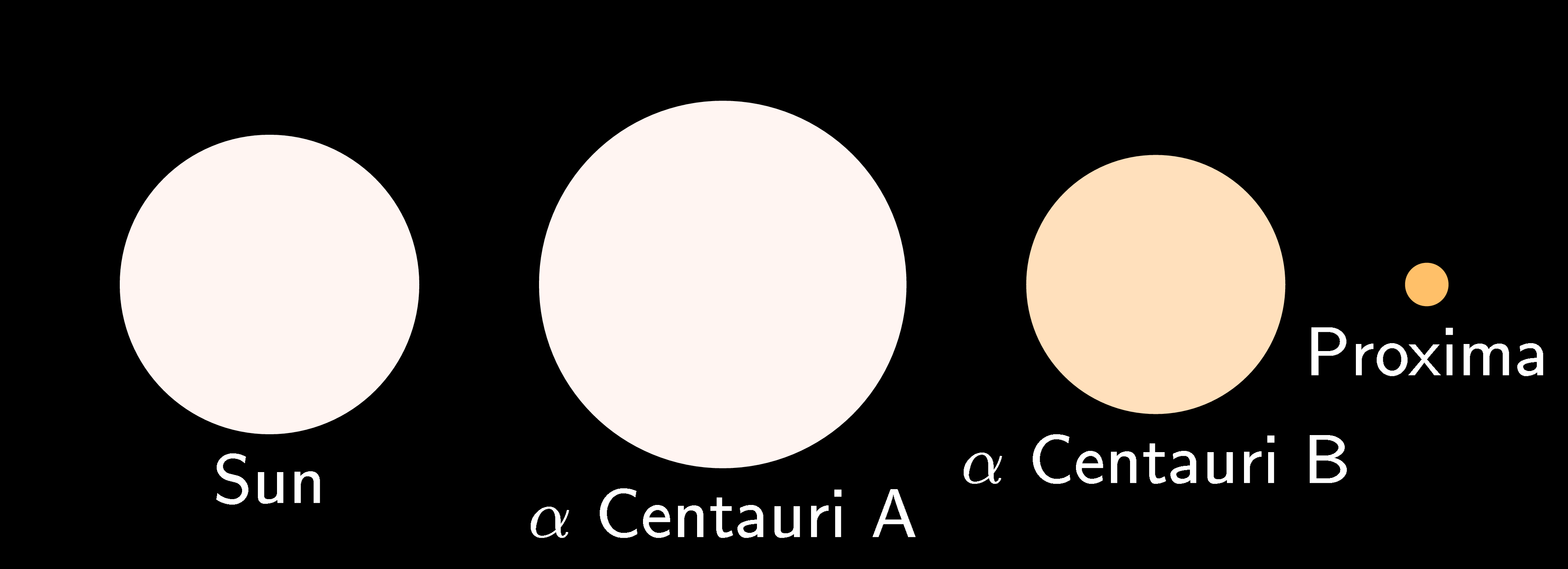Firstly:
Stars are really really far away. The Sun is the closest star to us, and its 92.96 million miles away. Since light actually travels at a speed, 670,616,629 miles per hour, it takes an entire 8.317 minutes for light to travel this distance from the Sun's surface to our eye here on Earth. This means that if the Sun were to suddenly vanish, we wouldn't even know about it for 8.317 minutes (check out this video for more on what would happen
Lights Out http://www.youtube.com/watch?v=rltpH6ck2Kc). The next closest star to us is Proxima Centauri at 29.943 trillion miles away. This is an easy one to remember because the word proxima means nearest to.
{The bright one on the left is Alpha Centauri}
This is so far away that its better to define its distance from us in light years, the distance that light travels in a year. Light takes 4.243 years to travel the 29.943 trillion mile distance from Proxima Centauri to Earth, making it 4.243 light years away. This also means that the light we see when we look up at it tonight is 4.243 years old.
The most distant object in the night sky is galaxy z8_GND_5296 at 13 billion light years away. For more on this check out
Star Far (http://www.science.tamu.edu/news/story.php?story_ID=1129#.UyFGslFdUpw).

So when you look up at the night sky beyond our solar system your actually looking from 4.243 years to 13 billion years into the past. Some of the stars that we see when we look up have actually long since died out (maybe thats why your wishing star hasn't come through for you). What the stars actually look like at the instant of looking up can only be estimated using astrophysical generalizations and formulas that project age progressions of the stars. If 70 light years away there were an alien that could see and zoom in on Earth, it would see war and genocide. If it were 66 million light years away, it would see dinosaurs and think of earthlings as giant creatures with short arms, having no idea of the catastrophe that would soon hit and make way for human evolution. If you go even further, anything looking at Earth from more than 3.8 billion light years away, which is the majority of the universe, wouldn't even know that there was life on Earth.
Side note: If we ever do figure out how to create warp drives or move faster than the speed of light, we'll be able to blast out to the necessary distance and aim our super advanced telescopes at Earth then watch Babe Ruth sliding home, or even a real Shakespearean play, We could even settle historical questions of religion.
Its kind of wild to try to conceive. We instinctually think of visual images as one instant, but what applies when we look at the stars applies when you look at anything. Things in our three dimensional realm all very in distance to us, so light that hits your eye from one object originates fractions of a second apart from that of another object. Therefore when you look around at things, you are looking at different times and actually perceiving a calage of both time and space. Images, in brain and on paper, in fact aren't true moments, they are moments of perception.
Sorry, that was a rather abstract rational all to get you ready for this link that will tell you what star is as many light years away from us as you are old.
http://outreach.jach.hawaii.edu/birthstars/year.php
If you are 22.1 years old the light from a star 22.1 light years away will just be arriving now and left the surface of the star 22.1 years ago, the day you were born. I think its pretty cool. If your birthstar is visible overhead then you can look up at the star at light that is basically as old as you are. In other words, you are getting a look at the time you were born.
Secondly:
For those of you who read my recent post
Indian Givers on death by asteroid impact and thought to yourselves, "I've got to do something about these asteroids:"
Nastaroid http://www.bbc.com/news/technology-26528516
Nasa is looking for coders to help prevent the Earth from being smashed by an asteroid. If you identify a particularly threatening one from a ground based telescope, they'l give you $35,000. Get to it




4 points. I've always liked the intro to Contact, where the radio waves go backward in time they speed away from Earth (the scale is wrong, but whatever).
ReplyDeletehttps://www.youtube.com/watch?v=EWwhQB3TKXA